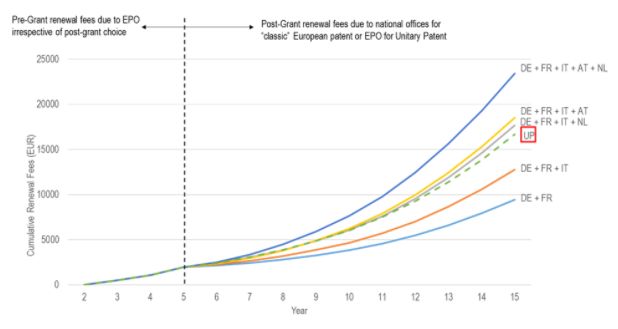- with readers working within the Advertising & Public Relations, Metals & Mining and Telecomms industries
One consideration when deciding between a Unitary Patent (i.e. a European Patent with Unitary effect) and a "classic" European patent (i.e. a collection of national patent rights obtained by validating a granted European patent) is cost. In this article, we will compare the costs of obtaining and maintaining a Unitary Patent with the costs of a "classic" European patent.
Renewal Fees
The below graph shows the cumulative cost of renewal fees for maintaining a Unitary Patent and for maintaining a "classic" European patent with different numbers of validations.

Before a Unitary Patent (i.e. a European Patent with Unitary effect) can be registered, the applicant must first obtain a European Patent from the EPO. Before grant, the same procedure is followed as for "classic" European patents (i.e. search and substantive examination by the EPO in accordance with the European Patent Convention).
There is no change to the pre-grant procedure for European patent applications. Consequently, renewal fees are still due to the EPO before grant, irrespective of whether a "classic" European patent or a unitary patent is desired. This can be seen in the graph, which shows the same renewal fee costs before grant.
However, after grant the situation is different. With a "classic" European patent separate renewal fees are paid to patent offices in each country in which the European patent is validated. In contrast, only a single renewal fee is payable to the EPO in order to maintain a Unitary Patent.
Whether it is more cost effective to pursue a Unitary Patent will depend on a number of factors including the desired territorial scope of the patent rights. In particular, this decision may depend on the number of countries, which have ratified the UPC agreement and are therefore included in the territorial scope of the Unitary Patent.
The graph also shows that renewal fees for a Unitary Patent cost roughly the same amount as maintaining 4 national patent applications using a "classical" European patent in the UPC participating states. Consequently, a Unitary Patent may be a cost-effective way of maintaining patent rights in a large number of European Countries. In those areas of technology in which European patents tend to be validated only in two or three of the states participating in the UPC, the renewal fee payable for Unitary Patents constitutes an increase in cost.
Furthermore, maintaining a Unitary Patent only requires the payment of a single renewal fee per year to the EPO. As a result, administrative costs may be reduced compared to "classic" European patents of similar territorial scope, which would require the payment of multiple renewal fees.
That being said, it is worth noting that the "Unitary Patent" is a single right that covers all of participating member states. As a result, it is not possible to reduce the number of territories covered (and therefore the amount of renewal fees payable) as commercial priorities change. For example, it may be apparent part-way through the term of a patent that country "A" is no longer a commercial priority, but country "B" remains commercially important. With a "classic" European patent, it is possible let the patent in country "A" lapse, whilst maintaining protection in country "B", reducing the renewal fee costs associated with the patent portfolio. This is not possible with a Unitary Patent because failure to pay the single renewal fee will cause the patent to lapse in all territories that the Unitary Patent has effect in.
Validation
In the discussions above, the only costs that are considered are the costs of maintain a Unitary Patent. However, it is also important to consider the cost of obtaining a Unitary Patent or a "classic" European patent.
Patent proprietors are not obliged to obtain Unitary Patents and can, instead, continue to validate granted European patents to obtain a bundle of national patent rights. The associated validation costs include the costs of filing forms at the patent offices of the validation countries and can also include the cost of translating part of the patent specification into an official language of the country in which the patent is to be validated. Although the London Agreement has reduced the amount of translation required, a number of countries still require translations of the claims and/or the description into an official language of their country. Consequently, the validation costs of a classic European patent are not insignificant.
In contract, the cost of obtaining a Unitary Patent is low. For example, there is no official fee for filing a request for unitary effect. During a transitional period at the start of the Unitary Patent system, a single translation of the application does need to be filed with the EPO (either into English, or into any other official EU language depending on the language of proceedings), but "The text of
such translations shall have no legal effect and shall be for information purposes only" [Article 6(2) EU Regulation No 1260/2012]. Consequently, obtaining a Unitary Patent can be lower-cost than obtaining a "classic" European patent.
Conclusion
In summary, the advantages of a Unitary Patent with respect to cost include: Low validation costs (no official fees) and lower renewal fees when a large territorial scope is desired. Whereas the disadvantages of a Unitary Patent with respect to cost includes higher annuity costs if protection in only a small number of countries is desired as well as the inability to selectively abandon countries as time passes to reduce renewal fee burden.
The content of this article is intended to provide a general guide to the subject matter. Specialist advice should be sought about your specific circumstances.
[View Source]


